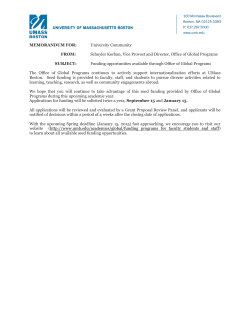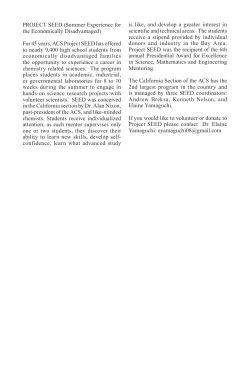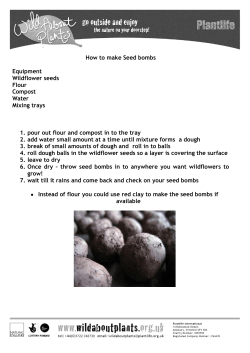
Chlorpyrifos Toxicity in Green Gram (Vigna radiata L.)
Journal of Environmental Treatment Techniques 2015, Volume 3, Issue 1, Pages: 25-27 J. Environ. Treat. Tech. ISSN: 2309-1185 Journal web link: http://www.jett.dormaj.com Chlorpyrifos Toxicity in Green Gram (Vigna radiata L.) M. Santhoshkumar, L. Baskaran∗, T. Mahakavi and T. Ravi mycin Department of Botany, Annamalai University, Annamalai Nagar-608002, Tamil Nadu, India. Received: 25/11/2014 Accepted: 22/01/2015 Published: 30/03/2015 Abstract The recent experiment was conducted to assess the effect of insecticide (chlorpyrifos) on seed germination and vegetative growth characteristics of Green gram vigna radiate L. This experiment comprised different concentrations of chorpyrifos treatments compared with control. The seeds were treated with the concentrations of 5 ppm, 25 ppm, 50 ppm, 75 ppm, and 100 ppm of chlorpyrifos. The seedlings were taken out at an interval of eight days for the germination studies. The results show that chlorpyrifos was reduced the green gram seed germination percentage significantly when the increasing of concentration of insecticide. The data suggested that chlorpyrifos affect the seed germination and it was possible to evaluate the toxicity of insecticide in plant. Key words: Chlorpyrifos, Germination, Green gram, ppm, Insecticide. 1 Introduction1 water is relatively short, from a few days to two weeks. It adsorbs readily to sediments and organic matter. The effect of chlorpyrifos was assessed based on morphological traits, root and shoot length (Zhi-Yong et al., 2011). Literature is rich in information referring to the phytotoxic and inhibitory effects of herbicides on germination root and shoot growth (Boutin et al., 2004).The effects of pesticides on seed germination, growth, survival, and yield and residue quantification of crop plants have been investigated by Ahmed and Khan (2011).The toxic effect of many fungicides, herbicides and insecticides on germination and seedling growth was carried out (Sengupta et al., 1986). By studying the effect of pesticides on treated seeds on germination and determination of growth indices, it is possible to evaluate the positive or negative influence or toxicity of the chemical compounds. Because germination experiments are easy, cheap, fast and spectacular, the testing of the action of some action of some known and newly synthesized substances on living organisms will be performed using germinating seed. Hence an understanding of hazardous effect of pesticides is also as equally as important to that of their use in the plant protection. This view point has received a great deal of attention by the researches in recent times. In the present study a preliminary attempt was to determine more exactly the impact of these pesticides on seed germination and early seedling growth of Vigna radiata L. In that way research work carried out following objective germination percentage, shoot length and root length in responses to chlorpyrifos. Pesticides were introduced to agriculture to perform the increased food needs of the growing global population. Indiscriminate use of various pesticides in modern age has led to a serious environmental hazard (Mishra et al., 2008). Pesticides are earlier reported to have affected non-target plants but their frequent application to the target plants is also a matter of concern. The application of different pesticides in a long term basis results in persistent ecological damages. The persistent nature of pesticides in the soil enables them to enter into the plants and other primary producers not only affecting the secondary and tertiary consumers that depended upon the producers. Chlorpyrifos (O, O-diethyl O-(3, 5, 6-trichloro-2pyridyl)phosphorothioate), is one such organophosphate insecticide effective against a broad spectrum of insect pests of economically important crops. Chlorpyrifos is widely used also for control of Coleoptera, Diptera, Homoptera, and Lepidoptera in soil. It has been suggested that the ability of chlorpyrifos and other organophosphorus pesticides to accumulate in living tissues may create a potential risk to humans and other organisms (Serrano et al., 1997; Wang et al., 2005).Chlorpyrifos produces hazardous effects on the environment when it is applied directly on plants or mixed with soil (Howard 1991). Chlorpyrifos adsorbs strongly to soil particles and it is not readily soluble in water. It is therefore immobile in soils and unlikely to leach or to contaminate groundwater. Chlorpyrifos may be toxic to some plants, such as lettuce. Residues remain on plant surfaces for approximately 10 to 14 days. This insecticide and its soil metabolites can accumulate in certain crops. The half-life of chlorpyrifos in 2 Materials and Methods Corresponding author: L.Baskaran, Department of Botany, Annamalai University, Annamalai Nagar-608002, Tamil Nadu, India. E-mail: basubotany@rediffmail.com. The green gram seed were purchased from registered seed centre at virudachalam, Tamilnadu, India. Morphologically identical seeds were selected, sterilized with distilled water and soaked in water for 12 hours. The germination was initiated by selecting batches of 20seeds 25 Journal of Environmental Treatment Techniques 201 Volume 3, Issue 1, Pages: 25-27 2015, that were germinated in Petri dishes upon two layers lay of filter paper containing concentration of, 5ppm, 25ppm, 50ppm, 75ppm and 100ppm.The seeds were incubated in Petri plate lined with moist blotter at 28±20 in dark. Germination time was determined as the time of rupture of seed coats, and the emergence of the radical through the seed coat. For seedling growth measurement, seedlings were allowed to grow in above concentrations. Eight-day Eight old seedlings were made on Germination rate. The germination rate of seeds was evaluated by counting the number of germinated minated seeds in batches of 20 seeds; each value represents the average of three repetitions. Measurements were made of the length of shoots and roots of the germinated seeds, respectively. time above said parameter were decreased while increasing the pesticide concentration (3.58, 3.58, 3.38, 2.70, 2.31, 2.10 and 2.71, 2.51, 2.12, 1.89, 1.11 cm) respectively. Fayez et al., 1994 proposed that chlorsulfuron and metsulfuronmethyl herbicide induced injuriess of the root growth in Pisum sativum and Zea mays and also reported the inhibition of seed germination and seedling growth in Penesetum americanum L. due to the application of organophosphate insecticides. Dimethoate insecticide affects the growth, photosynthetic ynthetic pigments and photosynthetic activity of Glycine max L. (Panduranga et al., 2005). KangetsuHirase and WilliamT.Molin (2002) revealed that MT-101 MT decreased germination of hemp sesbania by 57 and 90 % at 0.05 and 0.5mM, respectively. Vidyasagar et al., 2009 suggested that different concentrations (0.2, 0.4 and 0.6%) of endosulfan showed a significant decrease in percent germination, shoot length, root length and biomass decreased in Sorghum bicolor (L.) Moench. Tricyclzole fungicides have decreased thee germination of (Oryza ( sativa L). at 0.05% and 0.1% concentrations.(Sathees Kannan et al., 2014). 3 Results and Discussion The treatment of Green gram seeds with different concentrations of chlorpyrifos showed a significant decrease (p≤0.05) 0.05) in germination percentage when compared with control. (Fig 1).A seed germination of 96% was seen in case of control while the significant decrease 91%,86%,78%,69% and 64% germination nation were observed in seeds treated with 5 ppm, 25 ppm,50 ppm,75 ppm and 100 ppm respective chlorpyrifos solutions after eight days interval. Similar result also reported by (Mishra et al., 2008 have reported that effect of on the seedling characteristics of Vigna mungo L. The exposure of an organophosphorous insecticide, chlorpyrifos proved depressing for nitrogen metabolism and plant growth in Vigna radiata L. (Parween et al., 2012).The blocked growth might have resulted from the inhibition of normal cell division or elongation. Margaret and Manuel (2014) reported that pesticide of DDT on seed germination recorded a decrease of 50% (Vigna sinensis) and 20% (Oryza Oryza sativa) in the highest concentration. ion. The combination hexaconazole and triazophos reduced the germination 0.1%, 0.1% 0.15%, 0.2%, and 0.3%concentrations in spinach and gaur ( Kengar et al., 2014). 6 Shoot Length in cm 5 4 3 2 1 0 Concentration of chlorpyrifos Figure 2: Effect of different concentrations of chlorpyrifos on shoot length of vigna radiata L. 80 4 60 40 3 Root Length in cm Germination % 100 20 0 Comcentratioon of chlorpyrifos 2 1 0 Figure 1: Effect of different concentrations of chlorpyrifos on seed germination of vigna radiata L. Fig-2 and Fig-33 showed that the various concentration of chlorpyrifos on shoot length and root length of Vigna radiata L. The maximum shoot length length(4.62 cm) and root length(3.14 cm) were observed in control plant at the same Concentration of chlorpyrifos Figure 3: Effect of different concentrations of chlorpyrifos on Root length of vigna radiata L. 26 Journal of Environmental Treatment Techniques 2015, Volume 3, Issue 1, Pages: 25-27 Chlorpyrifos applied at the MAC rate (0.1µg a. s. /l) significantly inhibited germination energy and germination (11.25%) of white mustard seeds, as compared to the control (91.3%, 93.5%, respectively) (t=76.67**) (Sonja Gvozdenac et al.,2013). Mishra et al., (2014) result showed that the Profenofos has affect the germination at level 0.2% concentration up to 26.5% and also root and shoots length decreased with the increase in profenofos concentration. According to Cavusoglu et al., (2011) 100, 250 and 500 mg l-1 doses of glyphosate caused 24%, 40% and 60%, decrease of seed germination, significantly decreased the root length of Allium cepa. A.Sarmamy et al., (2013) reported that Treflan, Cyrin was decreased seed germination of Triticum aestivum L. at 8%, and 60% respectively. vigna radiata L. seedlings: Studies on morphology and pigments. Int.J.Adv.Bio.Res. 4(3): 265-270. 11- Panduranga MG, Mahadeva PG, Sudarshana MS.(2005). Toxicity of different imbibitions periods of dimethoate on germination, chlorophyll a/b, and dry matter of Glycine max (L) Merrill. Cv. KHSB-2, during early seedlings growth. J Physiol Res 18:199–201 12- Parween, T., Mahomooduzzafar, S. J. and Fatima, T.(2012). Evaluation of oxidative stress in Material Safety Data, Vigna radiata L. in response to Chloropyrifos, Int. J. Env. Sci., &Technol., 9,605-612. 13- Romilly Margaret Mendez and Bincy Manuel. (2014). Studies on the Tolerance of Vigna Sinensis L. And Oryza Sativa L. To The Application of Pesticides. J.envi sci.toxi.food & Tech. 8(6):13-18. 14- Sathees Kannan T. M., M. Rajesh and Kaliyamoorthy Jayakumar.( 2014). Effect of Fungicide Sivic on Seed germination and Seedling Growth of Oryza sativa L. Int.J. Mod. Bio. And Med., 5(1): 1-4. 15- Sengupta.P, K. A. Chakrabarti, and S. K. Banerjee. (1986). Biochemical changes induced by Toxic concentration of Malathion in germinating Wheat seeds, Curr Sci, 55 (10): 492-494. 16- Serrano, R., Lopez, F.J., Hernandez, F., Pena, J.B. (1997). Bioconcentration of chlorpyrifos, chlorfenvinphos and methidathion in Mytilus galloprovincialis. Bull. Environ. Contam. Toxicol. 59: 968–975. 17- Sonja Gvozdenac, Dušanka Inđić and Slavica Vuković. (2013). Phytotoxicity of Chlorpyrifos to White Mustard (Sinapis alba L.) and Maize (Zea mays L.): PotentialIndicators of Insecticide Presence in Water. Pestic.Phytomed. (Belgrade), 28(4): 265–271. 18- Vidyasagar G.M,D.Kotresha,N.Sreenivasa and Ramesh Karnam. (2009). Role of endosulfan in mediating stress responses in Sorghum bicolor (L.) Moench. J. Environ. Biol. 30(2): 217-220. 19- Wang, L.G., Jiang, X., Mao, Y.M., Zhao, Z.H., Bian, Y.R.,(2005). Organophosphorus pesticide extraction and cleanup from soils and measurement using GCNPD. Pedosphere 15: 386–394. 20- Zhi-Yong, Z., Wei-Li, S. & Wen-Cheng, S. (2011). Phytotoxicity and uptake of chlorpyrifos in cabbage. Envi. Chem. Let, 9(4):547-552. 4 Conclusion The obtained data indicates that chlorpyrifos affect of the seed germination of vigna radiate L. So the remediation is very important one for chlorpyrifos pollutant then only we make the good environment. References 1- Abdul-ghany o. I.sarmamy, shelan m. Khidir.(2013). Effects of some soil treated pesticides on growth characteristics of faba bean and wheat plants.Int.J.Eme.Tech.comp & App.sci. 5(1): 07-20. 2- Ahmad.M, and M. S. Khan.(2011). Plant growth promoting fungicides-tolerant Rhizobium improved growth and symbiotic characteristics of lentil (Lens esculentus) in fungicide applied soil, J. Plant growth Regul, (23):32-39. 3- Boutin, C., Elmegaard, N. & Kjar, C.(2004). Toxicity testing of fifteen non crop plant species with six herbicides in a green house experiment: implications for risk assessment. Ecotoxicology, 23, :354-369. 4- Fayez, K. A., Gerken, I. and Kristen, U.(1994). Ultrastructural responses of root caps to the herbicides chlorsulfuron and metsulfuronmethyl.Plant Soil 161:18. 5- Howard PH (ed) (1991). Handbook of environmental fate and exposure data for organic chemicals. In: Pesticides, vol III. Lewis Publishers, Chalsea, MI. 6- Kangetsu Hirase and WilliamT.Molin.(2002). Effects of MT-101and NOP on germination and seedling growth of hemp sesbania and rice. Weed Science, 50:386-39I. 2002. 7- Kengar Y.D, A.B.Kamble and A.B.Sabale.(2014).Effect of hexaconazole and triazophos on seed germination and growth parameters of spinach and gaur. Ann.Bio.Res, 5 (5):89-92 8- Kultigin cavusoglu, Emine yalcin, Zafer turkmen, Kursad yapar, Kursat cavusoglu, Figen cicek. (2011). Investigation of Toxic Effects of the Glyphosate on Allium cepa.J.Agri.sci. 17: 131‐142. 9- Mishra, R. K. and Mohanty, B. K. (2008). Effect of an insecticide Endocel, 35EC (Endosulfan) on the Seedling characteristics of Black gram Vigna mungo L. Plant science Research, 30(1&2) :92-95. 10- Mishra, I. P., Sabat, G. & Mohanty, B.K. (2014). Phytotoxicity of profenofos 50% ec (curacron 50 ec) to 27
© Copyright 2025









